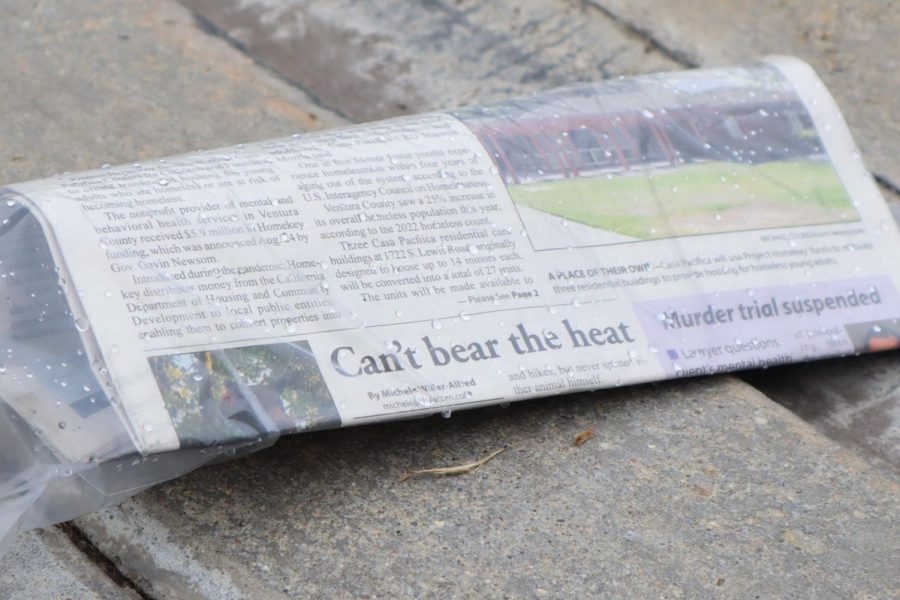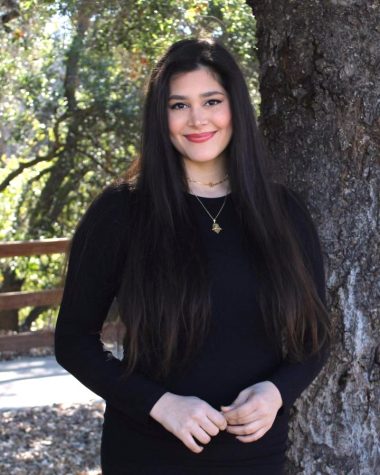Expected downpour turns into a heavy let down for Ventura County residents
A print edition of this week’s Acorn newspaper lies on a damp driveway in Camarillo, CA. The headline, “Can’t bear the heat,” reads visibly beneath rain droplets on Sept. 10, 2022. Photo credit: Shahbano Raza
September 16, 2022
This past weekend, Southern California faced winds and rain brought on by Tropical Storm Kay following a severe 10-day heat wave. For many Ventura County residents, the storm did not live up to its expectations.
The highly anticipated Tropical Storm Kay was expected to bring heavy winds, rain and flooding up the Southern California coast, as mentioned in a key message advisory by the National Hurricane Center.
Many were pleased to hear news of rainfall following the heat wave and mega-drought prevalent across California. And while flood risks were a common concern, forecasters correctly posited that the rain would slow the spread of Southern California wildfires.
Regions such as Orange County and San Diego did receive heavy rainfall and flash flooding warnings. Ventura County; however, faced brief and insubstantial rainfall.
Ventura County resident Susie Harrison commented on the lack of downpour during Tropical Storm Kay.
“I was hoping for the storm to have a stronger impact of rain considering the water restrictions that were placed on California due to the drought,” Harrison said.
Second-year Moorpark College student Braden Baum spoke on the anticlimactic nature of the storm and explained how the storm actually cost him financially.
“I work as a server at an outdoor restaurant and when it was reported that Tropical Storm Kay was making its way to Southern California on Friday, I was called off of work,” said Baum. “I was disappointed how little the rainfall actually was because not only have we been in a drought, but I also lost money that day.”
Tropical Storm Kay reached hurricane status on Thursday morning, but the hurricane status did not last long. By Friday night, the storm became a post-tropical cyclone after diverting from the United States and Mexico border, as mentioned in a forecast discussion released by the National Hurricane Center.
The storm originated off the Pacific shores of Mexico and proceeded to move up the Baja California peninsula. The rain showers were expected to deliver several months to a year’s worth of water for California’s dry landscapes.
Although the storm did not live up to its expectation, some were still appreciative of the light rain that lasted throughout the weekend.
Ventura County resident Hunter Deniaud voiced his opinion on the matter.
“It was nice to have a little break from the raging heat and it was good for California to see some precipitation,” Deniaud said.
Since Tropical Storm Kay, the last tropical storm to be reported in California was the 1939 Long Beach tropical storm nicknamed “El Cordonazo.”
El Cordonazo lasted Sept. 15 to Sept. 25 and was one of the worst recorded storms in California’ history. The tropical cyclone passed over Catalina Island and collided with the coast of Long Beach. The 72 mph winds and 5.26 inches of torrential downpour hit downtown Los Angeles, flooding the region and creating $2 million in property damage.
While Tropical Storm Kay caused little to no damage in California, the potential for future tropical storms remains. To stay informed on current and future storms across the country, click here.










